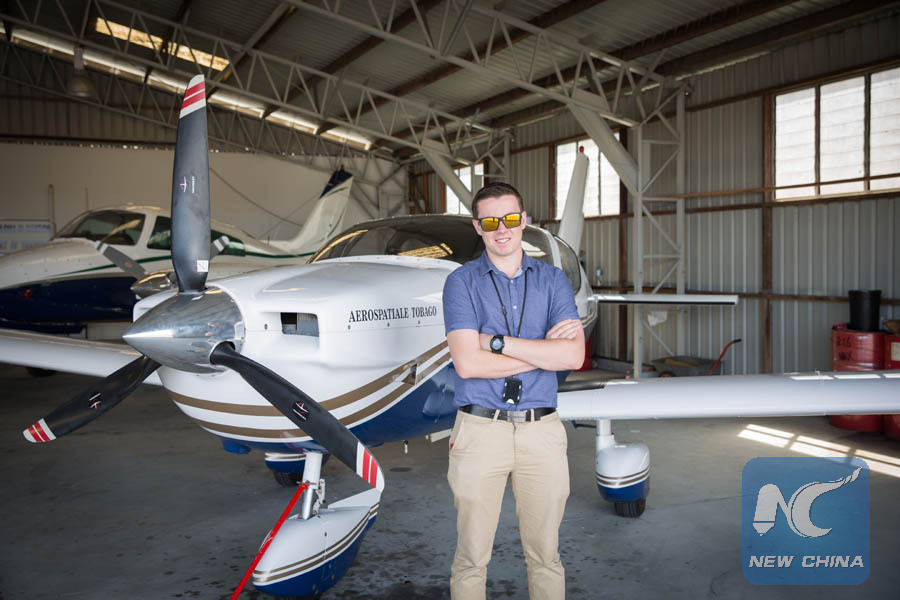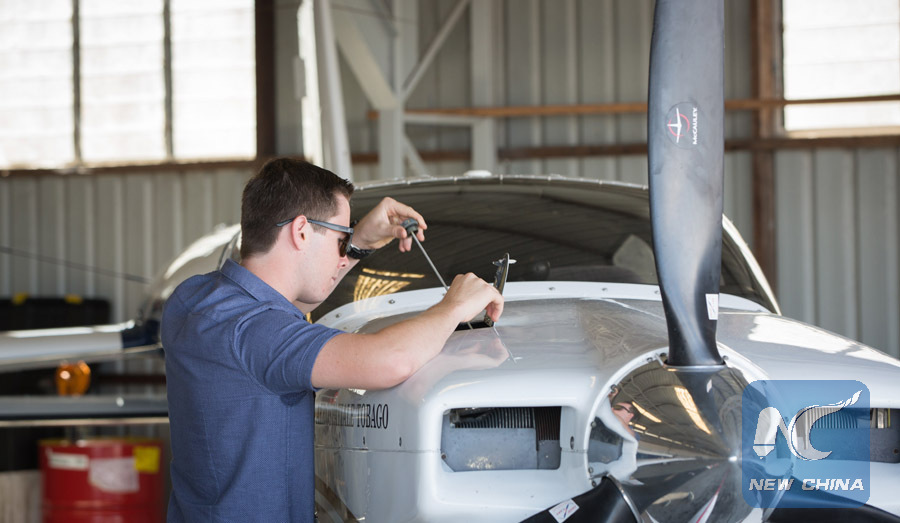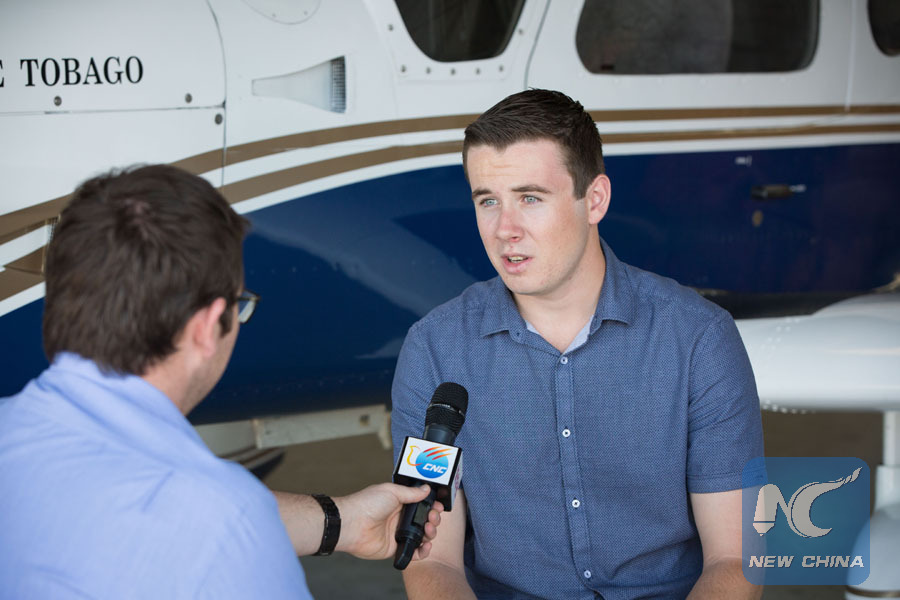
Lachlan Smart poses in front of a single engine aircraft in Sunshine Coast, Australia, Sept. 8, 2016. (Xinhua/Zhu Hongye)
SYDNEY, Oct. 5 (Xinhua) -- A relaxed 18-year-old young man walks into an aircraft hanger in northeast Queensland with his somewhat chuffed feet firmly planted on the ground. A month earlier, that was hardly the case.
Lachlan Smart is not your average teenager. On Aug. 27, he landed a little four-seater Cirrus at the Maroochydore airport on Queensland's Sunshine Coast, becoming the youngest person to circumnavigate the globe solo in a single engine aircraft.
It's that moment he will cherish, the wave of emotion after a tumultuous near three-year journey planning the feat that ended with a smooth touchdown to slowly taxi under the arc of water cannons, a salute to his achievement.
"It wasn't a feeling of excitement or a feeling of relief, it was just a combination of so may emotions, that feeling of success, (that) I've finally achieved this dream I've had for two and a half years, and a relief because I did the trip safely and it all pulled off," Smart told Xinhua in the hanger where he learned to fly.
Smart has always had a love for aviation since he was a young kid, watching aircraft land and take off at the Sunshine Coast airport with his mother.
"I just thought wow, that's amazing, I'm going to end up here one day," Smart said, adding his love truly blossomed once he put his hands on the controls for the first time.
Then, he got the crazy idea to become the youngest person to fly around the world solo in a single engine aircraft.
"I actually did it because I wanted to send a message to young people," Smart said.
Australia's millennial generation are feeling a little down. Smart's high school peers have dreams, goals and ambitions, yet they're missing the drive, the motivation to achieve in what's been described an "age of endless opportunity."
It's no wonder there's little motivation. Australian youngsters are saddled with record levels of student debt, a job market with high levels of underemployment and little security, an unaffordable housing market and stagnant wage growth, not to mention a perceived disconnect between political leaders and the needs of their younger constituents.
"I thought, maybe (flying around the world solo) will be a good way to show (younger generations) that if I did something really difficult ... they'll see that they can also achieve their dreams no matter how big or small they might seem," Smart said.
"It doesn't take an extraordinary person to achieve an extraordinary task."

Lachlan Smart checks the condition of a single engine aircraft in Sunshine Coast, Australia, Sept. 8, 2016. (Xinhua/Zhu Hongye)
An extraordinary task it was, though out of the reach of us mere mortals without copious amounts of money. It's estimated the solo around-the-world flight would have cost 350,000 Australian dollars (266,784 U.S. dollars), something Smart said he could never have afforded.
"Funding ... certainly presented a challenge for me," Smart said.
"This trip was something that we could never afford, the flight training wasn't something that we could afford to do, from the word go to when I achieved my dream."
It came down to being able to "sell" himself in front of prospective sponsors and business partners, lessons he intends to pass on following the solo flight.
Thankfully, the outlay wasn't all in cash, with 'in-kind' sponsorships footing the large costs. The use of a the single-engine Cirrus was donated from a sponsor just south on Queensland state's Gold Coast, while telecommunications was provided by Aussie giant Telstra Ltd, and insurance covered by QBE Insurance Group Ltd.
The trip was still uncertain up until the final months before take off on July 4: was there enough funding, were logistical issues finalised? If not for focus, tenacity and a strong support network behind the scenes, it wouldn't have gone ahead.
That focus and tenacity proved pivotal during the ambitious journey itself. Smart had to overcome significant obstacles along the way from torturous weather and turbulence to air traffic controllers and a 14-hour journey between Hawaii and California, draining both mentally and physically.
A 14-hour plane flight is almost routine for Australians wishing to travel to Europe, the catch for Smart though, he was alone and behind the controls. But, he never felt lonely, at least while in the air.
"One of the main challenges of this trip (was) that it is single pilot operations, there is no one else there flying with you, or helping you make decisions," Smart said.
"On the ground you do feel a bit homesick and a bit lonely at times when you've gone a month without seeing a single person that you know.
"But while I'm in the air, I stay very busy, I'm not thinking too much about home, I'm focusing on flying the aeroplane safely."
Safety, in any aspect of aeronautics is key. One testing situation, Smart was flying over Saudi Arabia on the leg between Oman and Egypt, where he encountered 5.5 hours of heavy turbulence.
"That was very straining physically, obviously, because you're being belted around so much," Smart said.
"It was straining mentally as well because you thought 'when is this going to let up?' It's presenting enough of a challenge as it is just trying to navigate this country with the heat and foreign air traffic controllers as it is, turbulence is just adding another factor.
"When I did get out of the aircraft, I was very sore because my back had been, all the joints had been compressed and then opened, and then compressed and then opened as the turbulence does.
"I actually had to sit on the wing for a little while once I got out just because I couldn't ah, couldn't put the pressure on my back straight away."

Lachlan Smart (R) receives an exclusive interview with Xinhua in Sunshine Coast, Australia, Sept. 8, 2016. (Xinhua/Zhu Hongye)
But it was all worth it for those stellar, memorable moments.
"That flight I took from England to France, that was very exciting," Smart said.
"I left an airfield my great grandfather flew out of in WWII in a freshly maintained aircraft after having 11-days rest, and seeing some family over there.
"So I was feeling great, (the) aeroplane was performing very well, and then I went and flew over the White Cliffs of Dover, which had been a dream of mine for a very long time. That was very exciting before making my way down to southern France."
It was all for that one issue, motivating the disenfranchised, those who have dreams themselves but no means of achieving them.
"I don't think ending this message on the 27th of August 2016 is good enough, I want to keep it going," Smart said, adding he is in the midst of setting up a company to establish "a more practical pathway for young people to get their goals and then achieve them through connections with business communities."
"Hopefully I've started to prove now the sky's not the limit."

